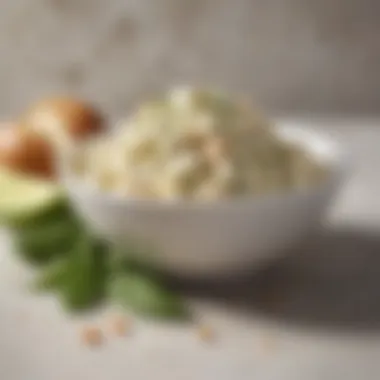Crafting the Perfect Caesar Salad Dressing: An In-Depth Guide


Recipe Overview
The Caesar salad dressing is an integral component of the well-known Caesar salad, characterized by its creamy texture and bold, savory flavors. It enhances the green romaine lettuce, croutons, and shaved Parmesan that define this dish. Understanding its role is essential for any culinary enthusiast aiming to master this classic preparation.
Origin and Cultural Significance
The origins of the Caesar salad and its dressing are a subject of intrigue. It is widely believed that this dish was invented in the 1920s by Caesar Cardini, an Italian immigrant who ran a restaurant in Tijuana, Mexico. The dish was created as a way to use what was available in the kitchen during a busy holiday weekend. Over time, the Caesar salad has transcended its humble beginnings, becoming a popular option in restaurants worldwide. Its cultural significance lies not only in its flavor but also in the creativity it inspires in modern chefs who experiment with its core components.
Ingredients List
Crafting the perfect Caesar salad dressing requires attention to detail and quality ingredients. Below is a complete list:
- Fresh garlic
- Anchovy fillets
- Egg yolks (or egg substitutes, if preferred)
- Dijon mustard
- Worcestershire sauce
- Fresh lemon juice
- Olive oil
- Parmesan cheese
- Salt and pepper to taste
Special Ingredient Notes
- Anchovy fillets: While traditional, they can be substituted with fish sauce or omitted for a vegetarian version. Be sure to taste and adjust seasoning.
- Egg yolks: Pasteurized eggs can be used for safety, particularly for those who may be concerned about raw eggs. There are also vegan options that use silken tofu or cashews as a creamy base.
- Olive oil: Opt for a high-quality extra virgin olive oil to enhance flavor.
Whenever sourcing these ingredients, it's advisable to look for local suppliers or farmers' markets for fresher produce. Some online retailers also provide specialty items like imported cheeses or gourmet oils.
Prologue to Caesar Salad Dressing
The Caesar salad dressing is a cornerstone of culinary tradition, celebrated for its rich flavor and creamy texture. Understanding the making and significance of this dressing allows culinary enthusiasts to appreciate the complexities involved. It serves various purposes in cooking, elevating not only the taste but also the experience of the dish.
A successful Caesar salad dressing balances various flavors and textures, satisfying the palate. It contains ingredients known for their ability to harmonize—such as umami-rich anchovies, zesty garlic, and creamy cheese. Each component contributes to the overall profile, offering a burst of taste while maintaining a seamless blend.
Within this guide, readers will explore the origins, recipe variations, and essential ingredients that define Caesar salad dressing. This information will assist in creating a dressing that is not only authentic but also tailored to individual preferences, leading to a universally enjoyed dish.
Historical Origins of Caesar Salad
The origins of the Caesar salad are often traced back to Tijuana, Mexico, around the 1920s. Its creation is attributed to Italian immigrant Caesar Cardini, who developed it out of necessity during a busy Fourth of July weekend. Running low on ingredients, he combined romaine lettuce, croutons, and a simple dressing made from garlic, oil, lemon juice, and parmesan. The unique blend captured diners’ attention, causing the dish's popularity to skyrocket.
As the recipe spread, variations emerged. Many chefs sought to include anchovies and eggs, which became hallmarks of the classic Caesar salad dressing. This evolution reflects changing tastes and the dish's adaptability to different culinary contexts. Today, Caesar salad is a mainstay across restaurants and households, showcasing its lasting legacy in global cuisine.
Culinary Significance
Caesar salad dressing holds a critical place in the culinary world for several reasons. It is often seen as a benchmark for creamy dressings, inspiring countless adaptations and variations. The balance achieved in Caesar dressing serves as a lesson in flavor construction. The harmonious interaction between its elements—including the savory anchovies, fresh garlic, and smooth olive oil—offers insights into achieving a well-balanced dish.
Additionally, this dressing enhances the appeal of salads, making them popular among various diners. It provides an inviting alternative to more simplistic dressings, encouraging even the most reluctant eaters to enjoy greens. Understanding the significance of Caesar salad dressing goes beyond just making a meal; it's about appreciating the art of cooking and the flavors that unite cultures and traditions.
Key Ingredients Overview
In any culinary endeavor, the significance of ingredients can never be overstated. For Caesar salad dressing, this principle is especially true. Each ingredient plays a crucial role, contributing not only to the flavor profile but also to the texture and overall balance of the dressing. Understanding the key components allows cooks to appreciate the harmony that exists within the dressing, creating a rich and nuanced experience. This section will examine primary ingredients, highlighting their unique contributions.
Anchovies: A Defining Element


Anchovies are often a point of contention with some palates but crucial for an authentic Caesar salad dressing. These small fish add a depth of flavor that is hard to replicate. They provide a salty and umami-rich base that enhances the overall taste. Anchovies also act as a flavor bridge, bringing the other ingredients into harmony. When blended, they dissolve seamlessly, leaving a subtle yet impactful taste.
Garlic: Adding Depth of Flavor
Garlic is a vital ingredient, enhancing the complexity of Caesar dressing. Its strong and pungent flavor anchors the dressing, providing a bold counterpoint to the salinity of the anchovies. Fresh garlic is preferred over powdered garlic, as it introduces a zest that brightens the overall flavor. Moreover, garlic has health benefits, which further justifies its use. Its versatility also opens the door for variations in flavor intensity, depending on how finely it is minced or how long it is allowed to meld with other ingredients.
Mustard: An Essential Emulsifier
Mustard serves more than just a flavoring agent; it functions beautifully as an emulsifier. The presence of mustard in Caesar dressing ensures that oil and vinegar combine smoothly, preventing separation. It adds a necessary tanginess that complements the richness of other ingredients. Both Dijon and whole-grain mustards are popular choices, with their individual textures and flavors offering variations in the final product. Mustard’s role is both practical and flavor-enhancing, making it indispensable in this dressing.
Cheese Varieties: Parmesan and Beyond
Parmesan cheese is the traditional choice for Caesar dressing, known for its nutty and salty qualities. Freshly grated cheese delivers a stronger flavor compared to pre-packaged options, which can lack depth. Beyond Parmesan, alternatives like Pecorino Romano or even nutritional yeast for vegan versions add rich umami notes. Care should be taken in selecting the cheese type as it directly influences the overall flavor and texture of the dressing, allowing for customization based on taste and dietary preferences.
Olive Oil: The Basis of Emulsion
Olive oil forms the backbone of Caesar dressing, both in terms of flavor and consistency. High-quality extra virgin olive oil is recommended for its robust flavor and health benefits. The oil provides a smooth consistency and helps in achieving the perfect emulsion with other ingredients. The oil's richness balances the acidity of vinegar and enhances the overall mouthfeel. Different varieties of olive oil may introduce varied flavor profiles, allowing for creative expression within each recipe.
Eggs: For Creaminess and Stability
Eggs act as the emulsifying agent in Caesar dressing, contributing to its signature creaminess. Raw or coddled eggs are commonly used, but caution is necessary to ensure food safety. The eggs bind the oil and water-based ingredients together, yielding a stable mixture. For those concerned about raw eggs, substitutes like mayonnaise can achieve a similar creaminess while ensuring safety. The delicate balance that eggs provide is key to a well-crafted Caesar dressing.
The Preparation Process
The preparation process is critical when making Caesar salad dressing. It encompasses a combination of ingredients and techniques that work together to create the dressing's unique flavor and texture. Understanding this process ensures that culinary enthusiasts can replicate authentic Caesar salad dressing at home, enhancing their cooking experience. There are several elements to consider, including ingredient selection, preparation techniques, and the importance of flavor balance.
Step-by-Step Recipe Development
Creating Caesar salad dressing is an art that requires attention to detail. Begin by gathering all necessary ingredients: anchovies, garlic, Dijon mustard, egg yolks, lemon juice, olive oil, Worcestershire sauce, and Parmesan cheese. Each of these components plays a pivotal role in defining the dressing's taste.
- Start with a Base: Begin with two to three anchovy fillets. Finely chop them or mash them using the back of a fork. This step releases their flavor and ensures they blend smoothly.
- Add Aromatics: Incorporate minced garlic into the anchovies. Generally, one or two cloves are sufficient, depending on your preference. The garlic adds depth and warmth to the dressing.
- Mixing the Emulsifiers: In a mixing bowl, whisk together the mashed anchovies and garlic with a tablespoon of Dijon mustard. The mustard not only provides additional flavor but acts as a powerful emulsifier.
- Emulsion Creation: Introduce egg yolks, about one or two per recipe. Whisk vigorously until the mixture is combined and smooth.
- Incorporate Acid: Squeeze in fresh lemon juice. This ingredient brightens the flavor profile and balances the richness of the other ingredients.
- Blend the Oils: Gradually add olive oil while whisking continuously. The goal is to create a stable emulsion, resulting in a creamy texture. Maintain a slow, steady stream to prevent separation.
Emulsifying Techniques
Emulsification is the key to transforming a mixture of liquids that generally don’t combine well into a stable dressing. In the context of Caesar salad dressing, an emulsion prevents the oil from separating from the other ingredients. There are a few techniques to achieve this effectively:
- Continuous Whisking: A traditional and straightforward approach involves manually whisking the mixture. As you add the oil slowly, whisk rapidly to combine it, creating a creamy, homogenous dressing.
- Blender or Food Processor: For those seeking convenience, utilizing a blender or food processor can speed up the process. Combine all ingredients except for the oil first, then slowly drizzle the oil through the feed tube while the machine is running.
- Immersion Blender: This tool can be particularly effective. Place all ingredients in a tall container, then immerse the blender fully. Move it in circular motions to incorporate air and achieve emulsification.
Adjusting Consistency and Flavor
Once your dressing is complete, evaluating its consistency and flavor is essential. You want a creamy dressing that clings to the lettuce well. If the dressing seems too thick, consider thinning it out:
- Add Water or Lemon Juice: A teaspoon of water or lemon juice can help achieve a more desirable consistency without compromising flavor.
- Acidity Balance: Taste the dressing and adjust its acidity. If it leans too heavy on the oil side, an extra splash of lemon juice can restore a nice tang.
- Seasoning: Don’t forget to taste and adjust seasoning. A pinch of salt or additional grated Parmesan can enhance overall flavor, making the dressing more savory.
Remember: The end goal is a balanced flavor that complements the crispness of romaine and the nuttiness of croutons.
By following these steps and principles, anyone can master the preparation of Caesar salad dressing, creating a delightful counterpart to one of the most beloved salads.


Variations on the Classic Recipe
Creating the perfect Caesar salad dressing is an art that often raises the question of how far one can deviate from tradition. Variations on the classic recipe allow for flexibility and personalization, catering to both dietary preferences and culinary creativity. By embracing variations, cooks can maintain the essence of the Caesar dressing while exploring new flavor profiles and ingredients that enhance the dish's appeal. This adaptation can be essential for engaging a wide audience and inviting others to enjoy Caesar salad on their own terms.
Vegetarian Alternatives
For those who prefer not to eat meat, creating a vegetarian Caesar salad dressing requires a thoughtful approach. The traditional use of anchovies in classic recipes is often a point of contention. A vegetarian alternative can include miso paste, which imparts umami flavor similarly to anchovies. Using capers or even olives can also enhance the savory depth without compromising the vegetarian ethos.
Additionally, choosing a quality vegan Worcestershire sauce can replicate some of the anchovy flavors while keeping the dressing animal-product free. The key here is to ensure that the dressing still maintains a well-rounded flavor and creaminess, which can be achieved using either silken tofu blended into the dressing or high-quality plant-based mayonnaise.
Non-Dairy Substitutions
Dairy-free options appeal to those with lactose intolerance or individuals following a plant-based lifestyle. Rather than using traditional Parmesan cheese, consider nutritional yeast as an excellent substitute. Nutritional yeast provides a cheesy flavor without containing any dairy, making it suitable for vegan diets. Another possibility is using cashews that have been soaked and blended to a creamy texture, offering richness without dairy components. Many commercially available non-dairy cheeses can also work as a topping, enhancing the final dish. When crafting a non-dairy dressing, it’s crucial to balance the flavors to ensure that it retains the signature Caesar richness.
Herbs and Spices for Unique Flavors
Incorporating herbs and spices can add exciting nuances to traditional Caesar dressing. While garlic remains a constant in most recipes, experimenting with additional herbs such as parsley or basil may elevate the flavor. These herbs can bring brightness and freshness, offering a delightful contrast to the richness of the dressing.
Moreover, consider adding a pinch of smoked paprika or cayenne pepper for heat, or even Dijon mustard to bring a sharp tang. The ultimate goal when adding these elements is to create a dressing that complements the greens and other ingredients in the salad. Each of these adjustments can lead to a unique version that reflects individual taste preferences, making the Caesar salad infinitely adaptable.
"Tailoring the Caesar dressing to fit various diets and tastes allows more people to appreciate this classic dish while encouraging culinary exploration."
Through these variations, the Caesar salad dressing transitions from a stringent classic to a versatile, inclusive option. Embracing creativity and dietary needs not only enhances the dish but fosters a greater appreciation for the art of cooking.
Nutritional Considerations
When crafting the perfect Caesar salad dressing, the nutritional implications should not be overlooked. Understanding the caloric content and macronutrient breakdown of the ingredients helps in making informed decisions about serving sizes and overall dietary impacts. Furthermore, recognizing healthier alternatives provides options for those who may be more health-conscious or have specific dietary preferences.
Caloric Content and Macronutrient Breakdown
A traditional Caesar salad dressing typically contains several key ingredients, each contributing to its caloric and nutritional profile. Here are some essential components:
- Anchovies: These small fish are rich in omega-3 fatty acids. They add about 50 calories per ounce, along with protein and healthy fats.
- Garlic: For flavoring, garlic has a negligible caloric contribution, but it offers numerous health benefits, including antioxidant properties.
- Olive Oil: A primary ingredient, olive oil contributes around 120 calories per tablespoon. It's predominantly made up of monounsaturated fats, which are beneficial for heart health.
- Eggs: Typically, one large egg used in the dressing contains about 70 calories, packed with protein and healthy fats.
- Parmesan Cheese: About 20 calories per tablespoon, it adds calcium and protein to the mixture but can increase the overall fat content as well.
In total, a typical serving of Caesar dressing might yield around 150-200 calories, depending on the proportions used. Properly balancing these ingredients is crucial, especially when considering how they affect one's macronutrient intake: carbohydrates, proteins, and fats can all vary significantly based on the recipe.
Healthier Alternatives to Traditional Ingredients
Individuals seeking to reduce caloric intake or enhance nutritional profiles of their Caesar dressing have several alternatives to consider. Some options include:
- Greek Yogurt: Replacing traditional mayonnaise or oil with Greek yogurt can cut calories and increase protein content.
- Nutritional Yeast: This offers a cheesy taste without the saturated fat found in cheese.
- Vegan Mayonnaise: For a non-dairy option, vegan mayonnaise can substitute regular mayonnaise without sacrificing creaminess.
- Avocado: Using mashed avocado instead of eggs or adding it to the dressing can provide a creamy texture along with additional nutrients, such as potassium and fiber.
Exploring these healthier alternatives allows for a customized dressing that fits better tailored dietary needs.
In summary, knowledge of caloric content and exploring healthier options creates a framework that supports conscious eating while still enjoying flavors associated with classic Caesar salad dressing.
Serving Suggestions


The way a dish is served can influence its overall appeal and enjoyment. For Caesar salad dressing, serving considerations enhance the dining experience by complementing its rich flavors and creamy texture. When thinking about how to serve Caesar salad, pairings with proteins and side dishes play a crucial role. A thoughtful approach towards serving suggestions offers not just aesthetic value but also nutritional balance and taste enhancement.
Pairing with Proteins and Side Dishes
Choosing the right proteins and side dishes brings a well-rounded aspect to a meal featuring Caesar salad dressing. Here are key pairings:
- Grilled Chicken: This classic choice works well with the bold flavors of Caesar salad dressing. The smokiness from grilling enhances the entire dish.
- Shrimp or Prawns: Seafood provides a delightful contrast. A simple sauté with garlic complements the dressing without overwhelming it.
- Steak: A well-cooked steak adds elegance and richness, making the meal upscale. Slicing it thinly can be visually appealing, drizzled with dressing.
- Roasted Vegetables: Seasonal roasted vegetables provide a colorful and nutritious contrast. Think of items like asparagus, zucchini, or bell peppers.
- Croutons: Not exclusively a side dish, croutons take the role of a garnish. Their crunch balances the creamy dressing beautifully.
When selecting proteins, consider cooking methods that enhance flavors without overshadowing the dressing. Simplicity often works best.
Presentation Techniques
How the salad is presented can greatly influence the anticipation of a meal. Presentation techniques are vital to making the dish visually appealing. Here are some useful techniques:
- Use of Bowls or Plates: Deep bowls allow for mixing without spilling, while flat plates can showcase the ingredients beautifully.
- Layering Ingredients: Arrange the greens at the base, followed by protein, topping with croutons and dressing. This technique creates a refined look.
- Garnish: Utilizing fresh herbs like parsley or dill as garnish adds vibrancy. Also, a sprinkle of freshly grated Parmesan can elevate the visual appeal.
- Color Balance: Incorporate colorful vegetables or edible flowers to create a striking contrast against the romaine and dressing.
As a serving suggestion, the visual presentation should resonate with the ingredients used, harmonizing flavors and aesthetics.
"The presentation is key; it invites diners to experience the dish beyond flavors."
By thoughtfully combining these serving suggestions with Caesar salad dressing, the overall experience transforms into a delightful culinary journey.
Storage and Shelf Life
Understanding the storage and shelf life of Caesar salad dressing is crucial for maintaining its flavor and safety. Homemade dressing without preservatives can spoil quickly if not stored properly. The attention to how long it lasts, and the methods used to store it, directly influences the quality and healthiness of your dish. If you make a batch of dressing, proper storage can help ensure that every time you use it, it retains its intended taste and consistency. This section will guide you through essential storage techniques and highlight the signs that indicate spoilage.
Proper Storage Methods
To maximize the freshness and longevity of your Caesar salad dressing, consider the following storage methods:
- Refrigeration: Always store your Caesar salad dressing in the refrigerator. A sealed container can keep it fresh for about one week. Glass jars or plastic containers with tight-fitting lids are ideal.
- Freezing: If you want to prolong its shelf life, you can freeze portions of the dressing. Use an airtight container or freezer bag, leaving some space at the top as the liquid expands. You can expect the dressing to maintain quality for up to three months in the freezer.
- Separate Ingredients: If you plan to store your dressing for an extended period, consider storing some ingredients separately, such as freshly grated Parmesan or garlic. This can help retain the overall flavor and decrease spoilage risk.
- Avoid Temperature Fluctuation: Keeping your dressing at a stable temperature is vital. Avoid placing it in the door of the fridge, as the temperature here fluctuates more than in the main compartment.
Signs of Spoilage
Identifying spoilage in Caesar salad dressing can prevent unpleasant surprises. Here are some indicators that it may have gone bad:
- Odor: A sour or off smell is a primary sign of spoilage. Fresh dressing will have a rich aroma, primarily from the garlic and Parmesan. Any change can indicate it’s time to toss it out.
- Texture Changes: If the dressing has separated significantly or appears whippped or chunky when you stir it, this could mean it has spoiled.
- Mold: If mold is visible on the surface, do not attempt to salvage it. Discard it immediately.
- Taste: Lastly, if the dressing tastes off or bitter, it's best to avoid using it. While tasting for spoilage should be a last resort, it is an important check for quality.
Proper storage methods and meticulous observation can significantly extend the life of your Caesar salad dressing, allowing you to enjoy it at its best.
In essence, mastering how to store your dressing properly is just as crucial as the care that goes into making it. With these considerations, you can ensure your Caesar salad dressing remains safe and delicious.
Epilogue
The conclusion serves as the final reflection on the process of crafting a Caesar salad dressing. It emphasizes the importance of understanding both the essential ingredients and the methods used to combine them effectively. A well-prepared Caesar salad dressing is not just about taste, but also about balance and texture. The interplay of flavors creates an exceptional experience for anyone enjoying the salad.
One of the key takeaways is recognizing how crucial each ingredient is. For example, the anchovies provide a unique umami flavor, while garlic adds necessary depth. Mustard’s role as an emulsifier cannot be overlooked, as it helps achieve that creamy consistency. Acquiring a deeper understanding of these components empowers home cooks to experiment within the boundaries of tradition without losing the essence of the dish.
In terms of practical benefits, well-executed dressing enhances the overall meal satisfaction. It invites flexibility through variations that meet diverse dietary needs without compromising flavor. For instance, substituting traditional components with vegan or low-calorie options ensures the dish remains enjoyable for a broader audience.
"A Caesar salad dressing, when crafted with care, transforms ordinary greens into an extraordinary dish."
Ultimately, the careful preparation of Caesar salad dressing enriches the culinary experience. It embodies tradition while allowing innovation, providing a foundation for other salads and dishes. Thus, this conclusion synthesizes the journey begun at the first step of ingredient selection, leading ultimately to a dish that is both classic and adaptable.



